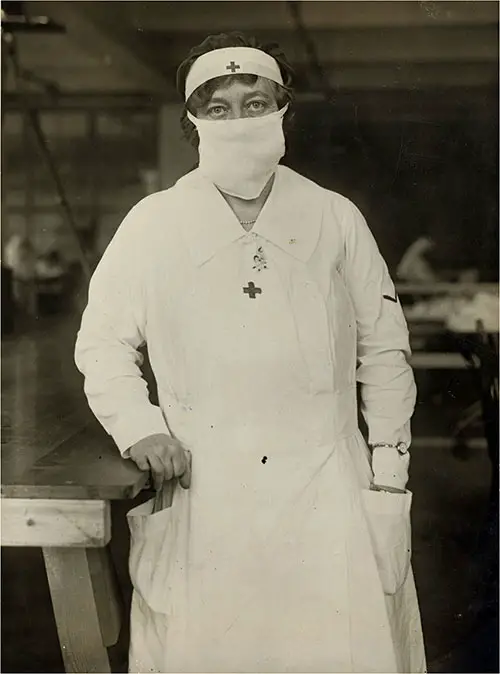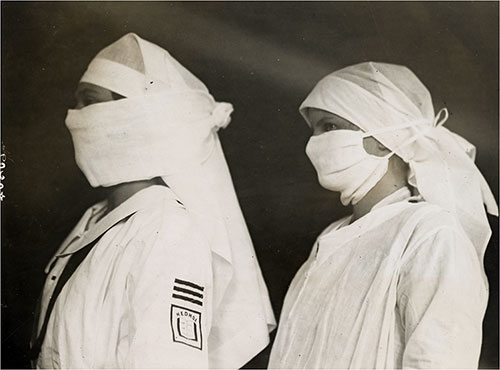How the "Flu" Mask Traps the Germ - 1918

Gauze Masks Prevent Spreading of Influenza. At the Red Cross Headquarters, Workers Are Busily Engaged in Turning out Gauze Masks to Prevent Spanish Influenza. Soldiers in Many Army Camps Are Wearing Them. Photograph © Underwood & Underwood 3 October 1918. National Archives and Records Administration RG 165-WW-269B-52. NARA ID # 45499393. GGA Image ID # 15074d34e6
A Large-Meshed Fish-Net hears about the same A sisal relation to a swarm of flies as the common gauze mask bears to the influenza germs it is supposed to stop; and for this reason doctors, and other persons who know something about germs, have been moved to comment either pityingly or sarcastically on the common public assumption that such masks afford protection.
The openings in an influenza mask, as seen under a microscope, are enormous, while the influenza germ, even under high magnifying power, remains almost invisible.
Nevertheless, public opinion is right, and a part, at least, of scientific opinion is wrong, for the influenza mask really does protect, and certain experts offer explanations as to how it does it.
A writer in Engineering and Contracting (Chicago) deals entertainingly with the beginning, progress, and present state of the controversy. The commonest argument against the "flu" masks, the writer notes, is that the openings in the mask bear the same relation in size to a microbe as a barn door to a mouse. For example, a doctor recently wrote to a daily paper protesting against the use of these masks. saying:
"If the gauze worn over the face is expected to prevent the entrance of microorganisms to the respiratory tract it seems that the absurdity would be apparent to those who know that Pfeiffer's bacillus, pneumococci, or streptococci, must be magnified many hundreds of times to be visible at all, and that if the ordinary gauze mask be magnified to the same extent it would show the meshes to be so large as to apparently offer no obstruction to the house-fly. Such an attempt to mechanically prevent germ invasion might be compared to fencing against fleas in Florida with barbed wire."
This, comments the writer of the article, sounds very plausible, but is fallacious reasoning. The very same sort of argument was used nearly half a century ago against filtering water to remove typhoid germs:
"The argument then took this form: 'The interstices between the grains of sand in a filter are as large compared with the typhoid bacillus as a house door is to a mouse."
"If all the doors of a house were open, a mouse could pass from garret to cellar without being stopped. How absurd, then, is the belief that a typhoid germ can be caught while wandering through a layer of sand a foot or two thick."
"It seems very 'absurd,' doesn't it? Yet when an actual count of the germs in a drop of raw water was made, and a similar count was made of the germs in the same water after filtration through a thin bed of sand, it was found that only one germ in a hundred had passed through! 'Incredible,' but true.
Of one hundred 'mice' that started in at the garret to go downstairs, only one reached the cellar, altho every door was open. Now this was no speculation or guess.
The microscope, after Dr. Robert Koch's discoveries forty years ago, could be used to count the microbes in a measured volume of water even as one might count mice in a trap. And the microscope made it certain that, somehow or other, porous filter sand does stop most of the microbes in water.
"It is eighty years ago this very year since a British civil engineer, James Simpson, finished at Chelsea, London, the first sand-filter plant for a city. It was intended primarily to remove the visible impurities of the Thames water.
Little did he or anyone else dream that the real danger in using that water was the invisible living things that inhabited it; for Pasteur had not yet shown that many diseases are caused by microbes, and Koch had not perfected the microscopic detection of germs. Yet it began at once to be noticed that typhoid fever was less prevalent than it had ever been.

Nurses Wear Protective Masks in Boston Hospitals During Influenza Epidemic, 1918. Photograph © International Film Service, New York. National Archives and Records Administration RG 165-WW-269B-44. NARA ID # 45499377. GGA Image ID # 150aed5d02
"Not until about forty years ago was it fully demonstrated that filtration can be so scientifically conducted, by the aid of microscopic counts of bacteria, as to remove almost all danger of contracting typhoid from drinking water.
"Then came another great discovery, namely, that a minute quantity of chlorin is deadly to typhoid germs. One drop of liquid chlorin in two barrels of water is the average dose, but it usually suffices to kill nearly every typhoid germ. When the discovery of chlorination of water was announced, it also was 'argued off the floor.' . . . 'Consider,' they say, 'the absurdity of trying to kill the millions of microbes in a barrel of water by merely adding half a drop of liquid chlorin.' Yes, it was perfectly absurd, but the microbes all died; perhaps by laughing themselves to death over the absurdity of it.
"In drawing an analogy between a flea and a microbe, several elements of difference are usually overlooked.' A flea not only is capable of locomotion, but can direct his motions by the sense of smell.
A microbe, on the other hand, is helplessly and aimlessly carried along by currents of air or water. In the case of microbes that are inhaled, it seems likely that most of them are either attached to particles of dust or to small globules of moisture. In either case, if the mask stops the grain of dust or globule of water the germ itself is caught also."
"How the 'Flu' Mask Traps the Germ," in The Literary Digest, New York: Funk & Wagnalls Company, Vol. LIX, No, 12, Whole No. 1496, 21 December 1918, p. 21.
